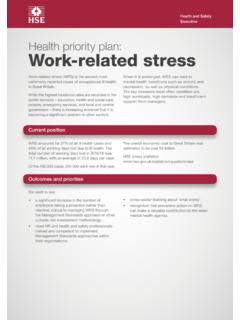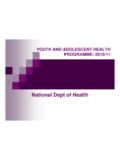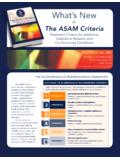Transcription of PREVENTING CANCER IN THE WORKPLACE LESS SMOKING, …
1 LESS SMOKING, BETTER BUSINESSW orking together to help employees quit smokingPREVENTING CANCER IN THE USE IS PROJECTED TO KILL 1 BILLION PEOPLE IN THE 21ST CENTURYEXECUTIVE SUMMARYA lthough great strides have been made in reducing tobacco use, 1 billion people smoke tobacco worldwide, causing 22% of all global CANCER deaths and costing the global economy billions of dollars each year in health care expenditures, productivity losses, fire damage and other costs. With 65% of the population aged over 15 years part of the workforce, the WORKPLACE provides a tremendous opportunity to reduce global smoking businesses, even if they have non-smoking workplaces, helping employees quit smoking can improve their bottom line through: Avoiding lost productivity and absences due to sickness Reducing healthcare costs Avoiding lost productivity due to people taking smoking breaksSupporting your employees to quit smoking should be part of investing in a broader healthy WORKPLACE culture which promotes employee engagement, organisational productivity, talent retention, and creativity and guide is designed to support you to implement a quit smoking initiative as part of a wider WORKPLACE health and Wellbeing programme.
2 We focus on proven effective initiatives, such as individual and group counselling, quitlines, medications, education, sms tools and smart phone apps. It also offers support for implementing a quit smoking initiative such as how to increase social support for quitting and guidance on which outcome measures to use to evaluate your programme in order to create the greatest return on investment. Given the global economic toll of tobacco of $500 billion a year there is a tremendous opportunity for business to implement cost effective support for their employees. Evelyn Bourke, Chief Financial Officer, Bupa Less Smoking, Better Business 34 Less Smoking, Better BusinessCONTENTSWHY SHOULD AN ORGANISATION HELP ITS EMPLOYEES TO QUIT SMOKING? 6 The global challenge 6 WORKPLACE support as a driver for change 6 The compelling business case 9 HOW TO BUILD A SUCCESSFUL QUIT SMOKING PROGRAMME 12 Assess 13 Create a value proposition for business leaders 13 Assess workforce readiness for quit smoking 14 Review WORKPLACE smokefree policies 15 Design 17 Assign responsibility for programme management 17 Design a programme based on what works 18 Individual Counselling 19 Quitlines 19 Using WORKPLACE communication channels to educate employees 19 Group counselling 20 Medications 20 SMS-based tools 21 Smartphone apps 22 Implement 24 Invest in a communications strategy
3 That inspires action 24 Address affordability as a barrier to participation 24 Be aware of opportunities to increase social support for quitting 25 Evaluate 28 Build in a framework for monitoring and evaluation 28 Less Smoking, Better Business 5 The Global ChallengeThe enormity of global health challenges such as CANCER and other non-communicable diseases (NCDs) is having a direct impact on business, driving up healthcare costs and budgets and exacting a heavy and growing toll on human The total economic impact of tobacco is $500 billion a year in health care expenditures, productivity losses, fire damage and other This is at a time when preserving workforce capacity and productivity is essential to sustaining economic growth in all support as a driver for changeCollectively, the private sector has a significant role to play in driving transformative change on a global scale in health and ultimately saving lives.
4 With approximately 65% of the population aged over 15 years part of the workforce, employers have the unique ability to create health -enabling environments and promote behavioural change to healthier lifestyles for the majority of the world s population. Quit smoking programmes provide a proven effective solution to dramatically increase the quit rates in smokers compared with smokers that try to quit unaided. In the UK, 12-month quit rates for the English stop smoking services were found to be 15% compared with an unaided quit rate of typically 3 to 4%, providing a strong rationale for integrating a quit smoking strategy within any health and wellbeing , national comprehensive cessation services with full or partial cost-coverage are only available to assist tobacco users to quit in only 21 countries, representing 19% of the world s There is no cessation assistance of any kind in one-quarter of low-income Even where there are cessation services, WORKPLACE promotion of adoption can be a valuable should an organisation help its employees quit smoking?
5 Smokers who use stop smoking services when quitting are four times more likely to succeed than those who quit unaided6 Less Smoking, Better Business The biggest opportunity for impact is to deal with the largest single factor contributing to the CANCER burden tobacco use. Tried, tested and proven mechanisms exist at an individual, community and policy level and are changing the norms towards the healthy choice. Workplaces and employers can take a lead on making tobacco-free living the easy choice. Cary Adams, Chief Executive Officer UICC MOST SMOKERS WANT TO QUITP ercent of current smokers who have ever tried to quit 2010 But only 19% of the world s population has access to tobacco dependence treatment servicesLess Smoking, Better Business 7 SMOKERS COST EMPLOYERS MORE THAN S IN IT FOR EMPLOYERS?
6 Extra annual costs:**Figures: Berman M, Crane R, Seiber E, et al. Tob Control Published Online First: June3, 2013 Less Smoking, Better BusinessThe Compelling Business Case For WORKPLACE health Smart and progressive businesses are investing time and resources in improving their employees health and managing wellness in the WORKPLACE , with demonstrable benefits to their bottom lines. These organisations recognise that WORKPLACE health and wellbeing is not just a nice to have , but that it makes great business sense with organisations that promote workers health being among the most successful over helping your employees quit smokingFor businesses, even if they have WORKPLACE tobacco-free policies, helping employees to quit smoking can improve the bottom line through: Avoiding lost productivity and absences due to sickness Reducing healthcare costs Avoiding lost productivity due to people taking smoking breaksWorkplace quit programmes deliver a measurable return on investment and can result in net cost savings within four Investments in quit programmes in the WORKPLACE can generate immediate cost benefits.
7 A US study found by investing $ to $ per member per month, an employer can generate a cumulative savings of $ to $ per member per month after five For companies in the European Union and Asia, a quit smoking initiative is among the top five interventions for cutting healthcare costs1. In the US, it was estimated that if all workplaces were smokefree, it would save over $60 million in medical costs within the first year and an estimated $280 million in the first seven Productivity gains from reducing the number of unsanctioned smoking breaks and absenteeism are substantial. Research by the UK Centre for Tobacco Control Studies found that smokers are 33% more likely to miss work than non-smokers and were absent for an average of extra days per Businesses benefit from reputation-building, by adding integrity and credibility to their brand, and improving their capacity to attract and retain use is a shared and modifiable risk factor for all five major non-communicable diseases (NCDs): cardiovascular diseases, CANCER , diabetes, chronic respiratory disease, mental health and neurological disorders.
8 NCDs place a heavy financial burden on societies, including through lost productivity in the WORKPLACE . Businesses have an opportunity and a responsibility to support their employees to quit smoking, through WORKPLACE initiatives and support Dain, Executive Director, The NCD Alliance Less Smoking, Better Business 9 Quitting smoking before middle age avoids more than 90% of the lung CANCER risk attributable to tobacco 1 1 Peto R, Darby S, Deo H et al. BMJ 2000: 321:323-92 Figure: Globocan 2012: Estimated mortality by age (15-69 years)10 Less Smoking, Better BusinessTobacco use is the single largest preventable cause of CANCER globally. Providing employees with the necessary tools and environment to help them quit smoking will have a major positive impact on their health and that of their families and friends.
9 Tobacco is like no other legally available product. It is addictive and kills up to half of its Reducing the rates of tobacco use will significantly decrease the global burden of a large number of cancers, including of the lung, oral cavity, larynx, pharynx, oesophagus, pancreas, bladder, kidney, cervix and stomach, and acute myeloid There is no safe level of tobacco smoking. The best thing a smoker can do for their own health and the health of family and friends is to quit smoking. The good news is that quitting at any age is beneficial, increasing life expectancy and improving quality of Healthier people have increased morale, motivation and job satisfaction. Quitting smoking makes a big difference to a person s wellbeing and quality of life. Quitting reduces the chances of impotence, having difficulty getting pregnant, having premature births, babies with low birth weights and SMOKING ADDS YEARS TO YOUR LIFEI ncreased Life ExpectancyLIVING SMOKEFREE IS THE HEALTHY CHOICE Less Smoking, Better Business 11 Creating a WORKPLACE quit smoking programme is a 4 phase , we provide guidance on establishing each phase of your programme supported by evidence, case studies, tools and resources that are designed to help guide your selection of a tailored solution for your TO BUILD A SUCCESSFUL QUIT SMOKING PROGRAMME Assess Design EvaluateImplement 12 Less Smoking, Better BusinessCreate a business case for leadersConvincing senior leaders of the financial and health benefits is essential.
10 Investing in the health and wellbeing of employees may already be integrated into strategic business plans but being convinced of the value of interventions to both the business as well as to your employees will be critical to moving forward. Understanding and being able to communicate to your colleagues the full health and financial benefits of engaging and motivating employees to quit smoking creates the foundation for any WORKPLACE programme. See Section 1 for more WORLD ECONOMIC FORUM 2010 WELLNESS APP The World Economic Forum 2010 Wellness app supports organisations to develop a robust business case to invest in a WORKPLACE wellness programme. The app is designed to estimate: The full cost of chronic disease within the employed population, including health care costs and loss of productivity over five years The potential savings from a customised wellness programme targeting relevant risk factors For more information, go to: We have recently been involved in supporting the provision of cessation support through partnerships with WORKPLACE health providers, individual workplaces and local government organisations.







